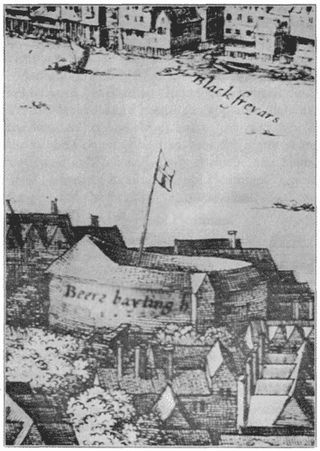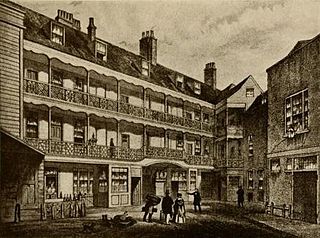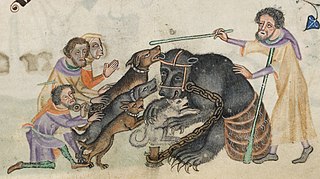
The English Renaissance theatre or Elizabethan theatre was the theatre of England from 1558 to 1642. Its most prominent playwrights were William Shakespeare, Christopher Marlowe and Ben Jonson.

Southwark is a district of Central London situated on the south bank of the River Thames, forming the north-western part of the wider modern London Borough of Southwark. The district, which is the oldest part of South London, developed due to its position at the southern end of the early versions of London Bridge, for centuries the only dry crossing on the river. Around 43 AD, engineers of the Roman Empire found the geographic features of the south bank here suitable for the placement and construction of the first bridge.
Philip Henslowe was an Elizabethan theatrical entrepreneur and impresario. Henslowe's modern reputation rests on the survival of his diary, a primary source for information about the theatrical world of Renaissance London.
The Rose was an Elizabethan theatre. It was the fourth of the public theatres to be built, after The Theatre (1576), the Curtain (1577), and the theatre at Newington Butts – and the first of several playhouses to be situated in Bankside, Southwark, in a liberty outside the jurisdiction of the City of London's civic authorities. Its remains were excavated by archaeologists in 1989 and are listed by Historic England as a Scheduled Monument.

Bull-baiting is a blood sport involving pitting a bull against dogs with the aim of attacking and subduing the bull by biting and holding onto its nose or neck, which often resulted in the death of the bull.

Bankside is an area of London, England, within the London Borough of Southwark. Bankside is located on the southern bank of the River Thames, 1.5 miles (2.4 km) east of Charing Cross, running from a little west of Blackfriars Bridge to just a short distance before London Bridge at St Mary Overie Dock. It is part of a business improvement district known as 'Better Bankside'.

The Swan was a theatre in Southwark, London, England, built in 1595 on top of a previously standing structure, during the first half of William Shakespeare's career. It was the fifth in the series of large public playhouses of London, after James Burbage's The Theatre (1576) and Curtain (1577), the Newington Butts Theatre and Philip Henslowe's Rose (1587–88).

Edward Alleyn was an English actor who was a major figure of the Elizabethan theatre and founder of the College of God's Gift in Dulwich.
In Renaissance-era London, playing company was the usual term for a company of actors. These companies were organised around a group of ten or so shareholders, who performed in the plays but were also responsible for management. The sharers employed "hired men" – that is, the minor actors and the workers behind the scenes. The major companies were based at specific theatres in London; the most successful of them, William Shakespeare's company the King's Men, had the open-air Globe Theatre for summer seasons and the enclosed Blackfriars Theatre in the winters. The Admiral's Men occupied the Rose Theatre in the 1590s, and the Fortune Theatre in the early 17th century.
The Admiral's Men was a playing company or troupe of actors in the Elizabethan and Stuart eras. It is generally considered the second most important acting troupe of English Renaissance theatre.

The Liberty of the Clink was an area in Southwark, on the south bank of the River Thames, opposite the City of London. Although situated in Surrey the liberty was exempt from the jurisdiction of the county's sheriff and was under the jurisdiction of the Bishop of Winchester who was usually either the Chancellor or Treasurer of the King.
The Earl of Worcester's Men was an acting company in Renaissance England. An early formation of the company, wearing the livery of William Somerset, 3rd Earl of Worcester, is among the companies known to have toured the country in the mid-sixteenth century. A later iteration of the company toured through the 1580s and '90s; little is known about its activities, though in 1583 it included the sixteen-year-old Edward Alleyn, at the start of his illustrious career.
Hockley-in-the-Hole was an area of Clerkenwell Green in central London where bull-baiting, bear-baiting and similar activities occurred in the 17th and 18th centuries. The Beargarden was located at Hockley-in-the-Hole where the Coach pub is today, at the junction of Back Hill and Ray Street, north of the junction of Clerkenwell Road and Farringdon Road.

The Hope Theatre was one of the theatres built in and around London for the presentation of plays in English Renaissance theatre, comparable to the Globe, the Curtain, the Swan, and other famous theatres of the era.
Francis Langley (1548–1602) was a theatre builder and theatrical producer in Elizabethan era London. After James Burbage and Philip Henslowe, Langley was the third significant entrepreneurial figure active at the height of the development of English Renaissance theatre.
Oberon, the Faery Prince was a masque written by Ben Jonson, with costumes, sets and stage effects designed by Inigo Jones, and music by Alfonso Ferrabosco and Robert Johnson. Oberon saw the introduction to English Renaissance theatre of scenic techniques that became standard for dramatic productions through the coming centuries.

The Fortune Playhouse was an historic theatre in London. It was located between Whitecross Street and the modern Golden Lane, just outside the City of London. It was founded about 1600, and suppressed by the Puritan Parliament in 1642.

In the historical era of English Renaissance drama, an Inn-yard theatre or Inn-theatre was a common inn with an inner courtyard with balconies that provided a venue for the presentation of stage plays.

Bear-baiting is a blood sport in which a chained bear and one or more dogs are forced to fight one another. It may also involve pitting a bear against another animal. Until the 19th century, it was commonly performed in Great Britain, Sweden, India, Pakistan, and Mexico among others.

Holland's Leaguer was the name of a Dutch English brothel in London between 1603 and January 1632. It has been referred to as the most famed brothel in 17th-century England. "Legeur" means military encampment.














